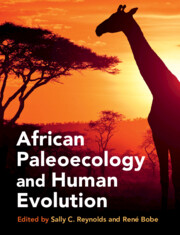Book contents
- African Paleoecology and Human Evolution
- African Paleoecology and Human Evolution
- Copyright page
- Dedication
- Contents
- Contributors
- Acknowledgments
- Part I Modern Africa and Overview of Late Cenozoic Paleoenvironments
- Part II Southern Africa
- 6 The Southern African Sites
- 7 Geology, Fauna, and Paleoenvironmental Reconstructions of the Makapansgat Limeworks Australopithecus africanus-Bearing Paleo-Cave
- 8 Paleoenvironments and the Context of Plio-Pleistocene Hominins at Kromdraai, South Africa
- 9 Using the Faunal Community to Determine the Local Ecology for Early Hominins at Cooper’s Cave at 1.5 Ma
- 10 The Paleoenvironments of Sterkfontein
- 11 Swartkrans: A Record of Paleoenvironmental Change in the Cradle of Humankind
- 12 Cornelia-Uitzoek: Paleoecology, Archeology, and Geochronology
- 13 The Paleoecology of the Australopithecus africanus Type Site at Taung, South Africa
- 14 Wonderwerk Cave, Northern Cape Province: An Early–Middle Pleistocene Paleoenvironmental Sequence for the Interior of South Africa
- Part III Eastern and Central Africa
- Part IV Northern Africa
- Volume References
- Index
- Plate Section (PDF Only)
9 - Using the Faunal Community to Determine the Local Ecology for Early Hominins at Cooper’s Cave at 1.5 Ma
from Part II - Southern Africa
Published online by Cambridge University Press: 19 May 2022
- African Paleoecology and Human Evolution
- African Paleoecology and Human Evolution
- Copyright page
- Dedication
- Contents
- Contributors
- Acknowledgments
- Part I Modern Africa and Overview of Late Cenozoic Paleoenvironments
- Part II Southern Africa
- 6 The Southern African Sites
- 7 Geology, Fauna, and Paleoenvironmental Reconstructions of the Makapansgat Limeworks Australopithecus africanus-Bearing Paleo-Cave
- 8 Paleoenvironments and the Context of Plio-Pleistocene Hominins at Kromdraai, South Africa
- 9 Using the Faunal Community to Determine the Local Ecology for Early Hominins at Cooper’s Cave at 1.5 Ma
- 10 The Paleoenvironments of Sterkfontein
- 11 Swartkrans: A Record of Paleoenvironmental Change in the Cradle of Humankind
- 12 Cornelia-Uitzoek: Paleoecology, Archeology, and Geochronology
- 13 The Paleoecology of the Australopithecus africanus Type Site at Taung, South Africa
- 14 Wonderwerk Cave, Northern Cape Province: An Early–Middle Pleistocene Paleoenvironmental Sequence for the Interior of South Africa
- Part III Eastern and Central Africa
- Part IV Northern Africa
- Volume References
- Index
- Plate Section (PDF Only)
Summary
Cooper’s Cave has been known as a hominin-bearing locality since 1938, when J.C. Middleton Shaw discovered the first hominin tooth there while exploring for fossils on the farm of a Mr. Cooper (Shaw, 1939, 1940). The site was described being about midway between Sterkfontein and Kromdraai, and had been extensively mined for lime, resulting in large dumps of breccia. Shaw’s senior assistant, Dr. Julius Staz, was searching through breccia dumps outside of what is today referred to as Cooper’s B using hammers and chisels to break up the rock when he discovered an upper third molar of some type of hominin. The obvious comparisons at the time were with Australopithecus africanus and Paranthropus robustus, although Shaw (1939) felt his tooth was more human-like than either of these taxa. In a later, more detailed discussion of the tooth, Shaw (1940) concluded that it did not belong to either australopith taxon, but was otherwise unwilling to allocate it taxonomically. Broom (1946) and Robinson (1956) later examined Cooper’s tooth, and concluded that it was probably an Australopithecus africanus upper left third molar. Unfortunately, the original tooth has been lost, leaving only a cast of the specimen behind. Berger et al. (1995) re-examined this cast, and agreed with Broom’s and Robinson’s conclusion that the tooth was likely Australopithecus cf. africanus. However, given the poor quality of the available cast, the taxonomic affinity of the specimen might be best considered unconfirmed.
- Type
- Chapter
- Information
- African Paleoecology and Human Evolution , pp. 86 - 91Publisher: Cambridge University PressPrint publication year: 2022



